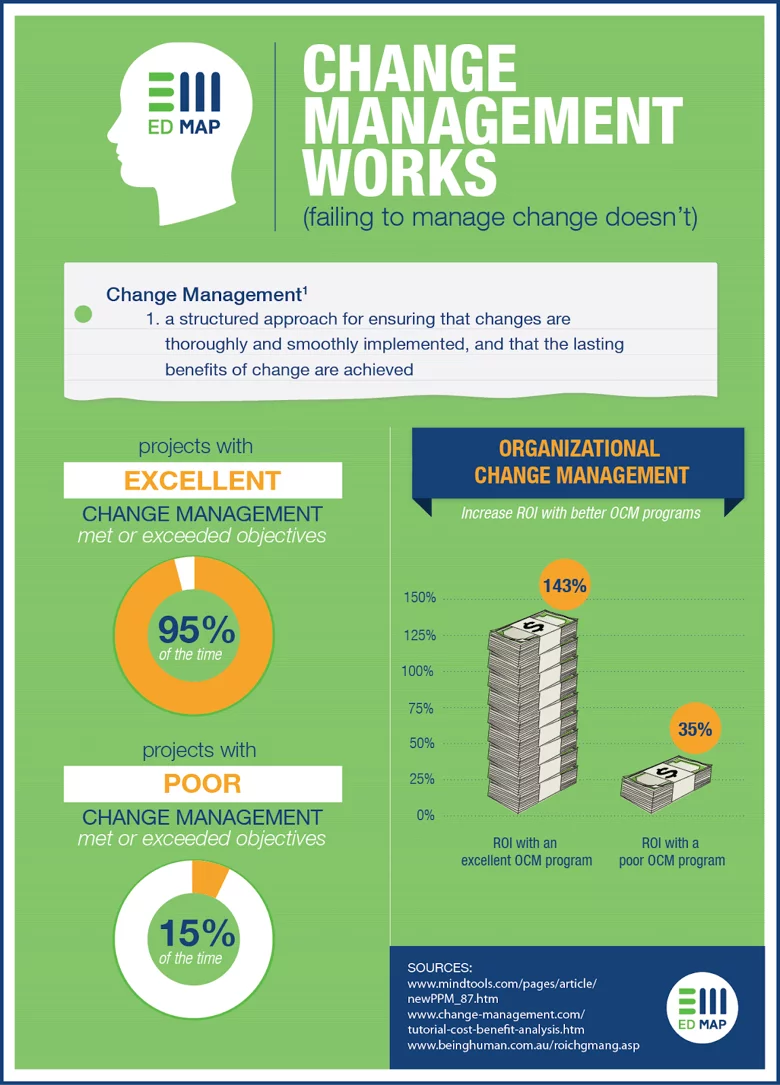
Change offers great promise, but that doesn’t mean its implementation is plain sailing.
In fact, it’s usually anything but that. Even with effective planning it’s common to run into numerous roadblocks, so your best bet is to prepare for the turbulence you’ll face along the way, while establishing your change management 101.
Courtesy of Frgimnasia
Change is probably most difficult in the early stages, but with flexibility, perseverance, and adaptability you’ll reap the benefits of transition.
The messy stages in between can be frustrating, but this is when it’s crucial you manage change successfully. Performance dips are to be expected, but the guidance of influential leaders can reduce their longevity.
Managing change isn’t a one size-fits-all approach, which can make it difficult knowing where to begin. Before you get started, it’s worth following a change management template, which will steer you in the right direction.
This can be used as a rough guide, from which you can create a plan tailored to your individual circumstances.
As a preparation strategy, consider using this change management template to assist you:
Change Management Template: Steps to Success
Stakeholder Analysis
This is an early step to success, which involves identifying the individuals in your organization who will be most affected by change.
These key players should become change champions, especially considering their influential status. They will be the first sponsors of change, and by promoting the benefits of change they’ll be able to get others to jump on board.
Enrollment is a top-down process, where if change is promoted for the good of the organization staff will be incentivized to embrace it.
Next, you can make informed predictions on what the reactions to change might be. Your preconceived ideas can be used as fire to fuel the communication strategy which will help your team understand change.
When your change initiatives are rolled out, it’s important you equip staff with the tools and resources they need to be successful. This can be achieved with advanced training, which should align with your overarching goals.
People will listen closely to leaders, so ensure they’re at the helm of educational initiatives. Employees will have an observant eye on proceedings, so you should be vigilant.
Everyone reacts differently, and to receive full sponsorship you should be accommodating. It is important to be a calming voice during these times, reassuring staff to take their time adjusting to unsettling circumstances.
Champion Early Adapters
Some people will embrace change more than others. These people should be celebrated for their adaptability, enthusiasm, and positive mental attitude.
Those who are energized by the concept of change are vital assets for your transition. Some will be eager to acquire new skills, and their interests will already align with your change goals.
Their receptivity can be used to your advantage, especially considering they’ll have a steeper progression curve. These people will be readily accessible, and available to influence the attitudes of those who are skeptical.
Change champions should have an advanced desire to learn, exceed expectations, and be firm change adopters.
The early change champions will learn what they need before anyone else, so will be ready to start training others as and when necessary.
They can do so by taking advantage of fun and engaging change management exercises.
They can provide real time feedback, develop new skills, and will be willing to devote their time to others.
Identify Common Mistakes
Your change management template should underline the roadblocks which could slow your progression.
This involves advanced communication, where staff should be given an opportunity to voice their concerns early and often.
This will give your an opportunity to put their mind at ease, or perhaps incorporate their input to improve your change procedures.
Creating a two-way dialogue will help staff feel actively involved in change, and therefore more likely to embrace.
Additionally, you should determine which roadblocks are specific to certain groups, and which could rear their ugly head organization-wide.
If you identify a group of resisters, support them, or if the roadblock is wide-reaching you can address it accordingly.
In this interview, @bobgalen, explains why in order to become #agile, people need to overcome their resistance to change. https://t.co/SiZ2E2BLNC #agiletransition #changemanagement
— StickyMinds (@StickyMinds) September 2, 2018
Change is a costly process, mostly because it takes longer than expected to realize the benefits. This is partly attributable to staff concerns, which can slow the onset of change.
It is your change management philosophy that can speed up the process, to encourage staff to embrace change in alignment with your expectations.
Of course this is rarely the case, so you must be patient and expect the unexpected. Bottom line improvements will take time, and you’ll probably end up investing additional resources into execution.
It makes sense to hire a change management consultant, who can assess your change process, and how quickly it’s advancing, free from bias.
They will make up one of many moving parts which are essential for successful change.
Remember, with change comes opportunity, and optimism can go a long way.
Hopefully you’ve found this change management template informative, and are one step closer to planning for a new era!
WalkMe Team
WalkMe spearheaded the Digital Adoption Platform (DAP) for associations to use the maximum capacity of their advanced resources. Utilizing man-made consciousness, AI, and context-oriented direction, WalkMe adds a powerful UI layer to raise the computerized proficiency, everything being equal.




